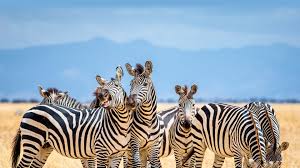
Tarangire National Park – a protected area in northern Tanzania, East Africa, known for its diverse wildlife and stunning landscapes
Tarangire National Park” represents a place where the unique and diverse ecosystems of the Tarangire River and its surroundings are conserved and managed for the benefit of both wildlife and visitors. It is a destination renowned for its abundant wildlife, including elephants, lions, and a wide variety of other animals, as well as its role in supporting wildlife conservation efforts in Tanzania.
About Tarangire National Park
Tarangire National Park is one of Tanzania’s lesser-known gems, located in the northern part of the country. It is known for its diverse and abundant wildlife, particularly during the dry season when large herds of animals gather along the Tarangire River. Here’s an overview of Tarangire National Park:
1. Location: Tarangire National Park is situated in the Manyara Region of northern Tanzania, approximately 118 kilometers (73 miles) southwest of Arusha. It is part of the northern safari circuit, making it easily accessible for tourists.
2. Size: The park covers an area of approximately 2,850 square kilometers (1,100 square miles), making it the sixth-largest national park in Tanzania.
3. Landscape: Tarangire is characterized by a diverse landscape that includes riverine forests, acacia woodlands, open savannah, and swamps. The park’s most prominent feature is the Tarangire River, which serves as a vital water source for wildlife during the dry season.
4. Wildlife: Tarangire is renowned for its high density of wildlife, particularly during the dry season (June to October). Visitors can expect to see a wide range of animals, including elephants, giraffes, lions, leopards, cheetahs, zebras, wildebeests, impalas, and more. The park is also home to a rich birdlife, with over 500 bird species recorded.
5. Elephant Migration: Tarangire is famous for its large elephant populations, and it hosts one of the largest elephant migrations in East Africa. During the dry season, elephants from surrounding areas gather in Tarangire to take advantage of the river’s water supply.
6. Birdwatching: Bird enthusiasts will find Tarangire to be a paradise for birdwatching. The park is home to numerous bird species, including colorful and rare birds like the yellow-collared lovebird, the Tanzanian red-billed hornbill, and the secretary bird.
7. Accommodation: Tarangire offers a range of accommodation options, including lodges and tented camps, catering to various budgets. Staying in one of these accommodations allows visitors to immerse themselves in the natural beauty of the park.
8. Safari Activities: The primary activity in Tarangire is game drives, where visitors can explore the park’s diverse landscapes and observe wildlife. Guided walking safaris are also available for those who want a closer and more immersive experience with nature.
9. Conservation: Tarangire National Park is part of the larger Tarangire-Manyara ecosystem, which plays a crucial role in wildlife conservation. The park contributes to the protection of various species and habitats in the region.
10. Accessibility: Tarangire is relatively easy to reach from major cities like Arusha and Kilimanjaro International Airport. It is often included in safari itineraries that also visit nearby national parks such as Lake Manyara and the Ngorongoro Conservation Area.
Overall, Tarangire National Park is a hidden gem in Tanzania, offering a unique and less crowded safari experience compared to some of the more famous parks in the country. Its diverse wildlife, stunning landscapes, and the opportunity to witness the annual elephant migration make it a must-visit destination for wildlife enthusiasts.
Tips to keep in mind when planning your visit Tarangire National Park:
Visiting Tarangire National Park in Tanzania is an exciting adventure for wildlife enthusiasts and nature lovers. Here are some important tips to consider when planning your visit:
Best Time to Visit:
- The dry season (from June to October) is the peak wildlife viewing season when animals congregate around water sources, making them easier to spot.
- If you prefer fewer crowds and lush landscapes, consider visiting during the wet season (from November to May). However, wildlife can be more dispersed during this time.
Park Entry Fees:
- Be prepared to pay park entry fees, which vary based on your nationality and the duration of your visit. These fees contribute to the park’s conservation efforts.
Accommodation Booking:
- Reserve your accommodation well in advance, especially if you plan to stay in the park or nearby lodges and camps. Accommodations can fill up quickly during peak seasons.
Guided Safari:
- Consider booking a guided safari with a reputable tour operator or guide. Experienced guides can enhance your wildlife viewing experience and provide valuable insights.
Safari Vehicle:
- Ensure that your safari vehicle is suitable for off-road driving, as the terrain in Tarangire can be challenging. A 4×4 vehicle is often recommended.
Health Precautions:
- Consult with a healthcare provider for necessary vaccinations and medications, including antimalarials, before your trip to Tanzania.
Travel Insurance:
- Purchase comprehensive travel insurance that covers medical emergencies, trip cancellations, and other unforeseen events.
Packing Essentials:
- Pack lightweight, breathable clothing for warm days and layers for cooler evenings and early mornings.
- Don’t forget a wide-brimmed hat, sunscreen, and insect repellent.
- Binoculars and a good camera with a telephoto lens are essential for wildlife photography.
Wildlife Viewing:
- Be patient and observant. Spend time near waterholes and riverbanks, where animals often gather.
- Maintain a safe distance from wildlife and follow your guide’s instructions for safety.
Cultural Respect:
- If you have the opportunity to interact with local communities, particularly the Maasai, be respectful of their customs and seek permission before taking photos.
Conservation Awareness:
- Educate yourself about the park’s conservation efforts and support responsible tourism practices by minimizing your environmental impact.
Safety Measures:
- Follow safety guidelines provided by your guide or park authorities, especially if you plan to engage in walking safaris or hiking.
Cash and Currency:
- While some lodges and camps accept credit cards, it’s advisable to carry some cash (Tanzanian Shillings) for small purchases and tips
Visiting Tarangire National Park provides a unique opportunity to experience the natural beauty and abundant wildlife of Tanzania. By considering these tips and planning ahead, you can make the most of your journey while contributing to the park’s conservation efforts.

Tree-Climbing Lions: One of the intriguing features of Tarangire National Park is the presence of tree-climbing lions. While lions are not typically known for their tree-climbing behavior, some prides in Tarangire have developed this unique skill. These lions can often be spotted resting in the branches of acacia and baobab trees, providing a truly unique and memorable sight for visitors. The exact reason for this behavior isn’t fully understood, but it’s believed that climbing trees offers them respite from the heat and biting insects, as well as a vantage point for spotting prey. It’s one of the distinctive characteristics of the park’s lion population and a fascinating aspect of Tarangire’s wildlife.
